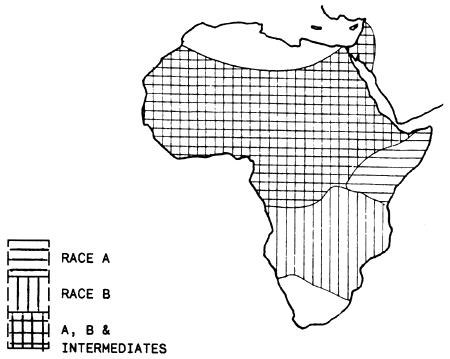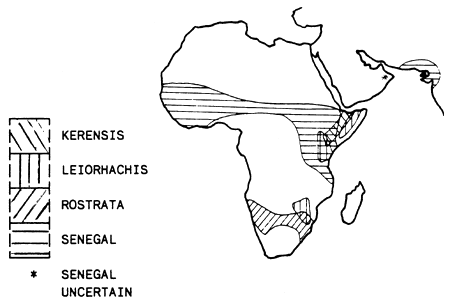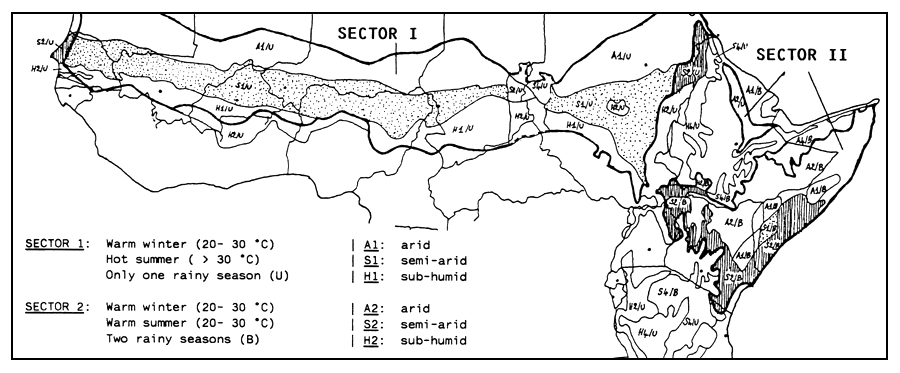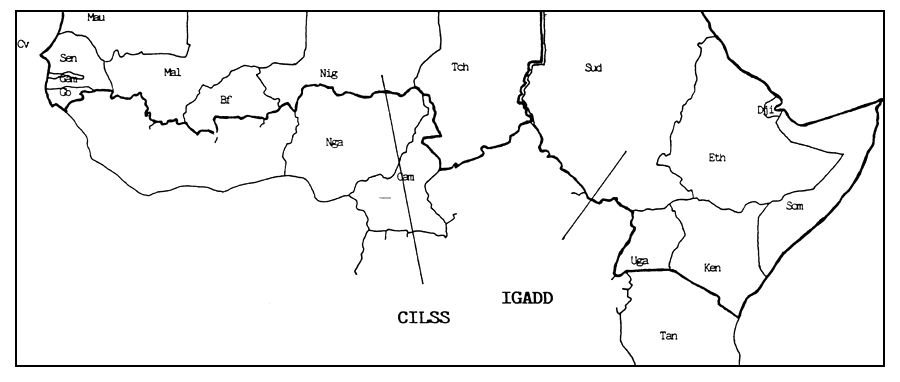by
H. de Framond
CTA, Project GCP/RAF/234/FRA
FAO, Rome, Italy
SUMMARY
In most Sudano-Sahelian countries insufficient capacity of the specialized services in the field of forest seeds and lack of adequately trained human resources are major constraints in afforestation policies. In this region priority should be given to development of national capacities for seed supply in order to develop local genetic resources, since these are well adapted to local conditions and meet local requirements.
Genetic improvement programmes should include selection of the best genotypes from natural forest populations. However, large-scale planting programmes are frequently not feasible in dry tropical areas, where the conditions for tree growth are critical, compared to more humid zones. In natural forest areas, afforestation programmes will always only complement natural forest management programmes. Accordingly, implementation of forest improvement programmes can only be justified for a limited number of species carefully selected for their economic/ecological value at a regional rather than at a national level.
This requires regional coordination in order to stimulate existing national programmes within this field. Such coordination should be based on existing regional initiatives/organizations such as CILSS2 or IGADD3.
The natural distribution of species/provenances and/or afforestation areas often cross the political borders of these organizations. Consequently, it is necessary to develop a flexible coordinating mechanism, which will enable implementation of appropriate measures regarding species, provenances and forest areas in general.
INTRODUCTION
The subregional FAO Project “Development of Genetic Resources of Multipurpose Trees and Shrubs” (Project GCP/RAF/234/FRA, funded by the Government of France) was initiated in January 1988 as a result of two regional workshops held in Nairobi (January 1986 and February 1987) organized by IUFRO4 in cooperation with FAO. The two workshops brought together participants from 14 countries of the Sudano-Sahelian region.
The programme is contributing technical assistance to 17 Sudano Sahelian countries of West and East Africa within the field of forest seed supply and genetic improvement of plant material. During its first 31 month, the project had prepared or contributed to the formulation of national project documents (for projects of five years duration), and assisted the countries concerned in submission of project proposals to donor agencies. In West Africa, where these activities were strengthened by active CILSS/FAO/IUFRO cooperation, an additional document for a regional support and coordination component for the nine CILSS member countries was formulated (CILSS/FAO/IUFRO, 1989).
Funding requirements for the regional programme in the CILSS countries are estimated at 20.4 million US$ over 5 years, of which 4.0 million US$ account for the regional coordination component, and 16.4 million US$ for national projects. The requirements for national projects in the other participating countries (Cameroon, Tanzania and four IGADD countries) are estimated at 21.5 million US$.
Furthermore, the project has contributed to preparation of a number of manuals and technical guides on seed collection and handling, with special reference to Sudano-Sahelian conditions. These guides/manuals propose a number of standard methodologies, for utilization by existing or future national institutions.
The objective of this article is to outline some technical and general policy aspects, important in development of woody genetic resources in the Sudano-Sahelian zone.
INCREASING NATIONAL CAPABILITIES FOR DEVELOPMENT OF LOCAL GENETIC RESOURCES
At present, most countries participating in the FAO project have no specialized service within the field of forest seeds. Often supply of plant material is a major constraint for afforestation programmes (Ouedraogo, 1988). Selection of species in forest nurseries is more frequently determined by seed availability than by local needs. This may result in selection of species with inadequate attention to socio-economic needs, or introduction of seeds of exotic species, which may not be properly adapted to local environmental conditions. Such seeds may even cause genetic pollution of local genetic resources, if they include hybridising species or provenances (Palmberg, 1980).
In the past, introductions of exotic species have often failed. Until results of species/provenance trials are available, priority should be given to local well adapted genetic material. This requires exploration of the available resources; selection of superior provenances and among those, superior phenotypes; identification of flowering and seeding periods for each species; and collection handling and storage of seeds until they are distributed for final use.
A prerequisite for these activities is establishment of national specialized services, with trained national staff and a certain minimum of equipment. Consequently, activities of the FAO project have primarily focused on this aspect.
SELECTION AND IMPROVEMENT OF PLANT MATERIAL FOR PRIORITY SPECIES AT REGIONAL LEVEL
Several forest areas in the Sudano-Sahelian zone are now endangered due to the combined effect of drought and increasing population pressure. Action for conservation is urgently needed.
Furthermore, it is desirable to select superior genetic material in order to improve the performance of plantations and to better serve the local people involved. However, under Sudano-Sahelian conditions, implementation of such programmes may meet economic constraints, such as the relatively limited importance given to afforestation programmes in dry areas due to high risk of failure, low socio-economic returns of most species concerned, difficulties in quantification of ecological benefits, etc.
In this context, a genetic improvement programme can only be justified for a few species carefully identified based on their social/economic/ecological value at a regional rather than national level. The regional approach is further emphasized by the fact that the natural distribution of species frequently cross national borders. A number of species commonly used in the region are listed in Table 1. As examples, the natural ranges of Faidherbia albida and Acacia senegal are shown in Figures 1 and 2.
While implementation of improvement programmes can be agreed upon for socio-economically or ecologically important species such as Acacia senegal (producing gum arabic), or Faidherbia albida (of high agroecological value), this is not the case for several other potentially important species.
As discussed above, genetic improvement programmes should be based on regional networks, stimulating national activities. For each species included in the activities, the geographical ranges of such cooperative networks should be determined according to the following criteria:
Natural range of the species (area where exploration activities can be carried out)
Planting range of the species (area where planting and improvement activities can be planned; may coincide with the natural range).
Distribution of homogeneous bioclimatic zones within the two areas above.
This approach can be illustrated using Faidherbia albida as an example. The natural distribution of Faidherbia albida and its different provenances are shown in Figure 1. From Table 1, an impression of its potential planting range in the Sudano-Sahelian zone can be obtained. In Figure 3 (from Unesco map of world distribution of arid zones), two main bioclimatic sectors in the range of the species are shown:
An area in West Africa (including a large part of the Sudan), with warm winter (20°–30°C), hot summer (over 30°C) and one single rainy season;
An area in East Africa (Ethiopia, Kenya, Somalia and a small part of Sudan), with warm winter (20°–30°C), Warm summer (20°–30°C) and two rainy seasons.
Such major environmental differences are likely to result in intraspecific variability. This is confirmed by recent provenance trials with Faidherbia albida in Burkina Faso (IRBET/CTFT, 1988). Four years after evaluation, provenances from East Africa (Sector 2), although initially superior to provenances from West Africa (Sector 1), later proved less well adapted to this new environment (Sector 1).
COLLABORATION ACROSS NATIONAL BORDERS AND UTILIZATION OF EXISTING SUBREGIONAL ORGANIZATIONS
Most of the Sudano-Sahelian countries belong to one of two organizations within the field of anti-desertification measures: CILSS in West Africa, and IGADD in East Africa (see Figure 4).
The mandate of these two organizations is to contribute to the improvement of subregional coordination between their member countries.
In West Africa, FAO in collaboration with CILSS and IUFRO, has formulated and implemented a regional programme for forest seeds (PRSF) (CILSS/FAO/IUFRO, 1989). This programme comprises 9 national projects (PNSF) which are controlled directly by the governments of the member countries. Also a regional support and coordination component (VR), which is managed by CILSS, has been established. This component includes training of national professional and technical staff on a regional level, harmonization of techniques and methodologies, technical support to national institutions, and actual coordination of technical activities and programmes.
At a workshop held in Ouagadougou on 25–26 October 1990, organized by CILSS, FAO and IUFRO, potential donors showed a positive interest in the programme. Project documents are now being submitted to donors by governments of member countries (PNSF) and by CILSS (VR).
FUTURE COLLABORATION ACROSS SUBREGIONAL BORDERS
Technical collaboration between the political groupings of CILSS and IGADD must be further developed and strengthened in the forestry field, to ensure harmonization of techniques and methodologies and facilitate transfer of information and genetic materials between these two subregions with largely similar ecological conditions. FAO is in a key position and as available and willing to assist in such harmonization, making use of its technical expertise and longstanding experience in the support to networking activities.
An additional argument for strengthening collaboration between CILSS and IGADD arises from the fact that biological/forestry interests, based on more detailed ecological zoning, are not homogeneous within each of these two groupings; for example Sudan, situated in eastern Africa and belonging to IGADD, has environmental conditions more closely related to those of West African countries than those in its own politico-geographical region.
A point to be stressed looking further into the future, is that the countries in the Sudano-Sahelian zone, presently actively strengthening their institutions and know-how in the genetic resources field, will later mainly be interested in collaboration directly related to very specific conservation and breeding activities, rather than training and harmonization of (already common) methodologies. A number of separate coordinated networks will therefore be needed, covering various combinations of countries in the Sudano-Sahelian zone; for example, the natural ranges of, and biological interest in, Faidherbia albida and Acacia senegal, are only partly overlapping, and networks created to further the development of these two species would not be totally identical. It is thus necessary to have a flexible approach to coordination, developing collaboration in common fields of interest through networking of researchers and research institutes, possibly using an approach similar to that of IUFRO and its species and subject specific Working Parties, or by making use of the already existing IUFRO mechanisms.
REFERENCES
Brenan, J.P.M. 1983 Manual on taxonomy of Acacia species. FAO, Rome.
CILSS/FAO/IUFRO. 1989 Programme Régional de Semences Forestières (9 project documents for national forest seed projects, 1 project document for regional support and coordination component, and 1 synthesis document). Unpublished.
Cossalter, C., D.E. Iyamabo, S.L. Krugman and O. Fugalli. 1987 Tree-improvement and silvo-pastoral management in Sahelian and North-Sudanian Africa. Problems, needs and research proposals. IUFRO, Vienna, Austria.
Institut de Recherche en Biologie et Ecologie Tropicales/Centre Technique Forestier Tropical. 1988. Rapport annuel d'activités du Centre Technique Forestier Tropical, Burkina Faso.
Ouedraogo, A.S. 1988 Séminaire régional sur les semences forestières. Ouagadougou, Burkina Faso, 11–15 janvier 1988. Synthèse des rapports nationaux. CILSS, Burkina Faso. Unpublished.
Palmberg, C. 1980 Principles and Strategies for the Improved Use of Forest Genetic Resources. In: Forest tree improvement. FAO Forestry Paper No. 20.
| Figure 1. | Figure 2. |
 |  |
| Approximate distribution of the species Faidherbia albida and its races. | Approximate distribution of the species Acacia senegal and its varieties. |

Figure 3. Part of the Unesco map of world distribution of arid zones.

Figure 4. Geographical areas covered by CILSS and IGADD.
Table 1. Representation of a number of important tree species in national afforestation programmes and the need for tree improvement programmes based on economic and ecologic importance and genetic variability.
| Representation of species in national afforestation programmes (%) | Criteria for selection | ||||||||||||||||||||
| West Africa | East Africa | Economic/ecologic importance | Genetic variability | ||||||||||||||||||
| Species | Burkina Faso | Cape Verde | Gambia | Gabon | Mall | Mauritania | Niger | Senegal | Tchad | Nigeria | Cameroon | Sudan | Ethiopia | Djibouti | Somalia | Kenya [%] | Tanzania [%] | (1) | (2) | (3) | (4) |
| Faidherbia albida | 2,3 | 2,1 | - | * | 1,2 | - | 2,4 | 2,7 | 2,8 | - | - | - | 7,6 | - | ** | 0,1 | ** | * | ** | *** | ** |
| Acacia nilotica | 6,7 | 2,1 | - | * | 0,7 | - | 6,2 | 3,0 | 5,2 | - | - | 7,4 | 6,3 | 9,2 | - | 0,4 | ** | * | ** | ** | ? |
| Acacia tortilis | 0,1 | - | - | - | 0,1 | - | 1,5 | - | - | - | - | - | 6,1 | 6,9 | ** | 2,1 | * | * | ** | ** | ? |
| Acacia senegal | 1,2 | 0,8 | - | * | 0,6 | * | 2,5 | 6,2 | 3,8 | - | - | - | 5,4 | - | - | 2,3 | ** | *** | *** | ** | ? |
| Azadirachta indica | 15,1 | 0,8 | 2,4 | * | 21,6 | - | 7,3 | 2,7 | 17,2 | - | - | - | 3,3 | 0,5 | ** | 1,2 | ** | * | ** | ** | ? |
| Balanites aegyptiaca | 0,0 | - | - | * | 0,3 | - | 0,5 | 1,1 | 10,4 | - | - | - | - | 0,1 | ** | 0,6 | * | * | ** | ** | ? |
| Boswellia spp. | - | - | - | - | - | - | - | - | - | - | - | - | - | - | ** | - | - | *** | *** | ** | ? |
| Eucalyptus camaldulensis | 26,1 | 4,8 | 2,3 | * | 22,7 | - | 10,9 | 15,5 | 4,8 | - | - | 3,1 | 19,4 | - | ** | 38,1 | ** | ** | *** | ** | ** |
| Khaya senegalensis | 0,7 | 1,4 | 10,1 | ** | 4,7 | - | 0,3 | - | - | - | - | - | - | - | - | - | - | * | ** | ** | ? |
| Parkia biglobosa | 3,5 | - | 2,8 | *** | 2,3 | - | 0,0 | - | - | - | - | - | - | - | - | - | - | *** | ** | ? | |
| Prosopis juliflora | 2,7 | 33,0 | 0,1 | * | 2,6 | *** | 37,8 | 15,3 | 24,7 | - | - | 1,1 | 2,4 | 4,4 | ** | 0,9 | * | ** | *** | ** | ? |
| Pterocarpus erinaceus | 0,0 | - | - | *** | 0,0 | - | - | - | - | - | - | - | - | - | - | - | - | * | ** | ** | ? |
| Ziziphus mauritiana | 1,3 | 2,3 | 0,0 | * | 0,6 | - | 3,2 | 0,9 | 2,1 | - | - | - | - | 0,7 | ** | - | * | * | ** | ** | ? |
Legend: [%]: percentage calculated as percentage of dry zone species only.
(1): economic value sensu strictu (monetary).
(2): economic value sensu lato
(3): ecological value
*: fair
**: high
***: very high
Source: Regional forest seed Programme/CILLS, 1989 (CILLS/FAO/IUFRO), National forest seed programmes in Sudan, Ethiopia, Djibouti and Tanzania (FAO), Kenya, Nigeria and Cameroon (FAO/IUFRO).
1 Manuscript received June 1990. Original in French.
2 The Permanent Inter-State Committee for Drought Control in the Sahelian Zone.
3 Inter-Governmental Authority on Drought and Development.
4 The International Union of Forestry Research Organization.